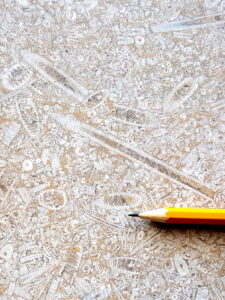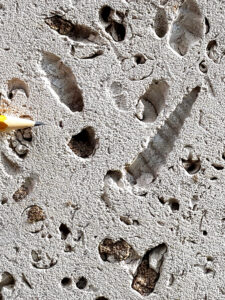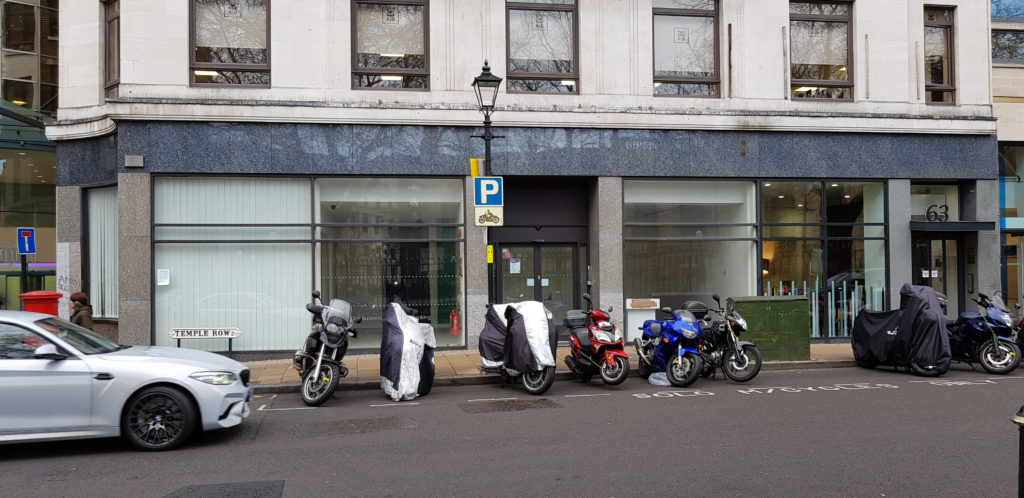Birmingham Building Stones Trails
References cited in the text are listed at the end of the trail. Hover over words in red (or click if you have no mouse) to see a definition (usually taken from Wikipedia). The stone varieties shown in green in the trail text can be found in our Index of Stones. The index also shows some of the buildings where the stones can be found and gives reference information about the stones.
Trail 3: Around the Shops
The name ‘Birmingham’ is derived from the Anglo-Saxon Beormingahām, alluding to the home of the Beormingas clan and their settlement here was probably established as early as the 7th Century A.D. However the centre remained a poor region until the later 12th Century when Peter de Bermingham, local lord of the manor, developed a market centre around his castle, in the area that is now the Bull Ring. From then Birmingham’s economy began to take off and it became established as a small market town. The Bull Ring has also been shown to be an area of light industry at this time. Archaeological excavations carried out during the latest phase of construction in the early 2000s have revealed evidence of potters’ workshops and leatherworks during the 13th Century.
 This building stone walk focuses on the old centre of Birmingham, around the church of St Martin in the Bull Ring and the surrounding shopping malls. The area demonstrates continuity as a centre for trade and retail but the building materials used here have changed beyond those that would have been familiar to Peter de Bermingham and his family. The area has been transformed over the last two decades, and though the oldest part of the city of Birmingham, it is now the symbol of a new vibrant centre, with the covered markets replaced by glamorous shopping malls. Malls are modern cathedrals in terms of delivering the double whammy of decorative stones and public access. They are built to impress and the polished surfaces provide excellent opportunities for observing fossils, minerals and textures. This walk will take in the new shopping precincts of the Bullring and Grand Central as well as the surrounding retail areas. It will end by taking a detour to Holloway Circus to visit the Pagoda.
This building stone walk focuses on the old centre of Birmingham, around the church of St Martin in the Bull Ring and the surrounding shopping malls. The area demonstrates continuity as a centre for trade and retail but the building materials used here have changed beyond those that would have been familiar to Peter de Bermingham and his family. The area has been transformed over the last two decades, and though the oldest part of the city of Birmingham, it is now the symbol of a new vibrant centre, with the covered markets replaced by glamorous shopping malls. Malls are modern cathedrals in terms of delivering the double whammy of decorative stones and public access. They are built to impress and the polished surfaces provide excellent opportunities for observing fossils, minerals and textures. This walk will take in the new shopping precincts of the Bullring and Grand Central as well as the surrounding retail areas. It will end by taking a detour to Holloway Circus to visit the Pagoda.
The main source on the architecture of the buildings visited, unless otherwise cited, is Pevsner’s Architectural Guide to Birmingham (Foster, 2007). Information on public artworks is largely derived from Noszlopy & Waterhouse (2007). This is the third and final part in a series of guides to the building stones of Birmingham City Centre (see Siddall et al., 2016a & b), produced for the Black Country Geological Society.

Rymans, 20 Temple Street
1. Rymans, 20 Temple Street
What appears at first glance to be an unassuming shop front is in fact one of Birmingham’s top fossils spots (right). It is clad with a limestone called Derbydene. This is an ‘encrinite,’ now a rather old-fashioned word, referring to a limestone predominantly composed of the fragments of crinoids. More correctly it would be called a biosparite today. However, here the crinoids are so spectacular that it seems fitting that we apply a rock name which draws attention to this. The crinoids here are big and cannot be missed, with ossicles a centimetre or so in diameter and articulated stem-sections up to ten or more centimetres in length. It is quarried from beds in the Lower Carboniferous (c.340Ma) Eyam and Monsal Dale Limestone Formations around the quarry district of Cromford in Derbyshire.
Walk up Temple Street towards the Cathedral and turn right into Temple Row to 61-63 Temple Row.
2. 61-63 Temple Row (Riva Blu restaurant, 2022)
The building on the corner of Temple Row and Needless Alley is properly called Union Chambers. It was designed in the 1930s by architects Ewan Harper, Bro. & Co. The ground floor was remodelled to accommodate the Allied Irish Bank which formerly occupied the premises. Looking up, the building is clad in Portland Stone, but of main geological interest here are the decorative granites used to clad the lower floor. Several granites, probably added at different times, are used to clad this building, which is why this façade looks a bit patchy.
We now turn to the granites which are used to clad the verticals around the door and between the windows. Unfortunately one of the main stones used is a granite of unknown origin, with blotchy, white plagioclase phenocrysts in a matrix of pale brown potassic feldspar, grey, translucent quartz and clots of black biotite mica. Also used are a very pale coloured leucogranite and a brown granite with strongly aligned phenocrysts. The leucogranite is a variety of Sardinian Granite, with phenocrysts of slightly yellowish feldspars. This colour effect is partly due to incipient alteration of these minerals to form clays. Some of these crystals also show zoning. Grey quartz and black biotite are also present. This stone is quarried from the Buddosò Pluton, located in the north east of the island of Sardinia. It was intruded during the Variscan Orogeny 300 million years ago.

Above, left to right, brown granite, Sardinian Granite and Cornish granite. All images are at the same scale, field of view = 15cm.
The darker-coloured, foliated granite is a variety of Cornish Granite. This texture is generally referred to as the ‘small-megacrystic type’ due to the brick-shaped feldspar phenocrysts, and granites with this texture were mainly acquired from the Carnmenellis and Bodmin Plutons. At 300Ma, the Cornish Granites are the same age as the Sardinian Granite above, and related to the same mountain-building event, the Variscan Orogeny. Both suites of granites were intruded late into this orogenic phase. Unlike the Sardinian Granites which contain only biotite mica, the Cornish granites are two-mica granites and silvery muscovite is a distinctive component of the stone used here. Biotite is present in black flakes, showing a weak alignment. Plagioclase and grey quartz are also present in the groundmass.
Next door, just across Needless Alley are the offices of the CBRE.

CBRE Building, 55 Temple Row
3. CBRE Building, 55 Temple Row

Fancy Beach Whitbed
Blaubrun Granite is used to clad the entrance façade at the top of the steps. ‘Blaubrun’ literally translates from the German as ‘blue-brown’, referring to the brown potassic feldspars and bluish, strained quartz. This blue colour is an optical effect. Blaubrun is a coarse-grained, ancient granite from Sweden, one of the 1.8Ga Flivik-Hökhult Suite, with the main quarries located in the Ångeholm Pluton. This suite of intrusive igneous rocks is part of the Transcandinavian Igneous Belt which runs from Lofoten in northern Norway for 1400km to Blekinge province in south-east Sweden. They were emplaced in the Småland region of south east Sweden. They are exposed along the coast and the quarries are only accessible by boat. The rock also contains biotite and plagioclase.
Walk 3 continues on the next page…
References can be found on the last page of the walk (3.5).

